Restoration for Intensity Nonuniformities with Discontinuities in Whole-Body MRI
Abstract
:1. Introduction
2. Patient and Data Description
2.1. Study Design and Ethical Approval
2.2. Patients and Data Description
- A -weighted (w) sequence in a Turbo Spin Echo (TSE) or a Fast Field Echo (FFE) technique,
- A Short Tau Inversion Recovery (STIR): This is an inverted pulse fat suppression method that, apart from the fat suppression, prolongs the w relaxation, and thus reduces the w signal. It furthermore prolongs the w relaxation, thus enhancing the w signal. All in all, STIR has an additive effect of enhancing the w signal. Thus, the STIR sequence offers weighted (w) and weighted (w) images, (w + w) images.
2.3. Preparation of the Data
3. Methods
3.1. Spatial and Statistical Image Representation
3.1.1. Spatial Image Representation
3.1.2. Statistical Image Representation
3.2. Effect of Spatial Intensity Nonuniformities in Co-Occurrences
3.2.1. Distortion in Co-Occurrences from Spatial Intensity Nonuniformity
3.2.2. Restoration from Spatial Non-Uniformity in Co-Occurrences
3.3. Bayesian Posterior Expectation for the Restoration
3.4. Spatial Image Restoration
3.4.1. Back-Projection of Restoration to Space
3.4.2. Anisotropic Smoothing of the Restoration Field
3.5. Iterative and Stable Estimation of Cumulative Intensity Restoration
3.5.1. Incremental Nonuniformity Correction Field
3.5.2. Iterative Estimation of Cumulative Intensity Restoration
3.5.3. End Condition for the Iterations
3.6. Valid Domains in Image Space and Statistics
3.6.1. Valid Signal Region of Images
3.6.2. Valid Dynamic Co-Occurrence Ranges in Statistics
3.6.3. Stability of Valid Co-Occurrence Ranges along the Iterations
4. Experimental Results
4.1. Data Quality
4.2. Implementation
4.2.1. Parameters of the Method and Their Values
 ,
,  , and
, and  . The value of the parameter is a tradeoff between computational complexity and accuracy of the method.
. The value of the parameter is a tradeoff between computational complexity and accuracy of the method.4.2.2. Computational Complexity of the Method
- Computation of the co-occurrence and the joint co-occurrence statistics:.
- Deconvolution of the statistics: .
- Back-projection to the image: .
- Gaussian smoothing of spatial nonuniformity: .
- MDL smoothing of spatial nonuniformity: , where is the connectedness in MDL smoothing.
- Multiplication of incremental spatial nonuniformity with cumulative spatial nonuniformity: .
4.3. Experiments and Validation with Whole-Body Images

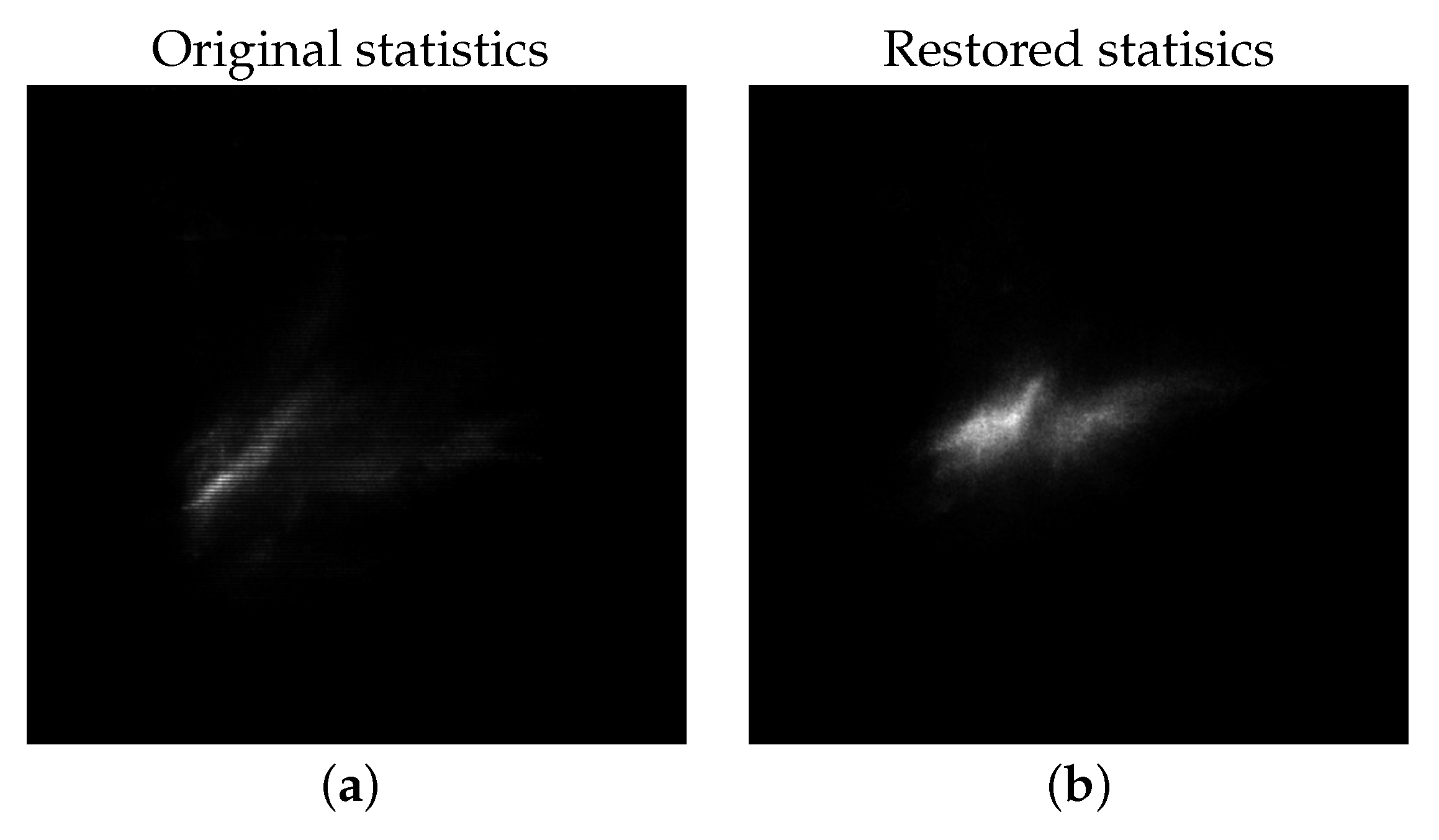
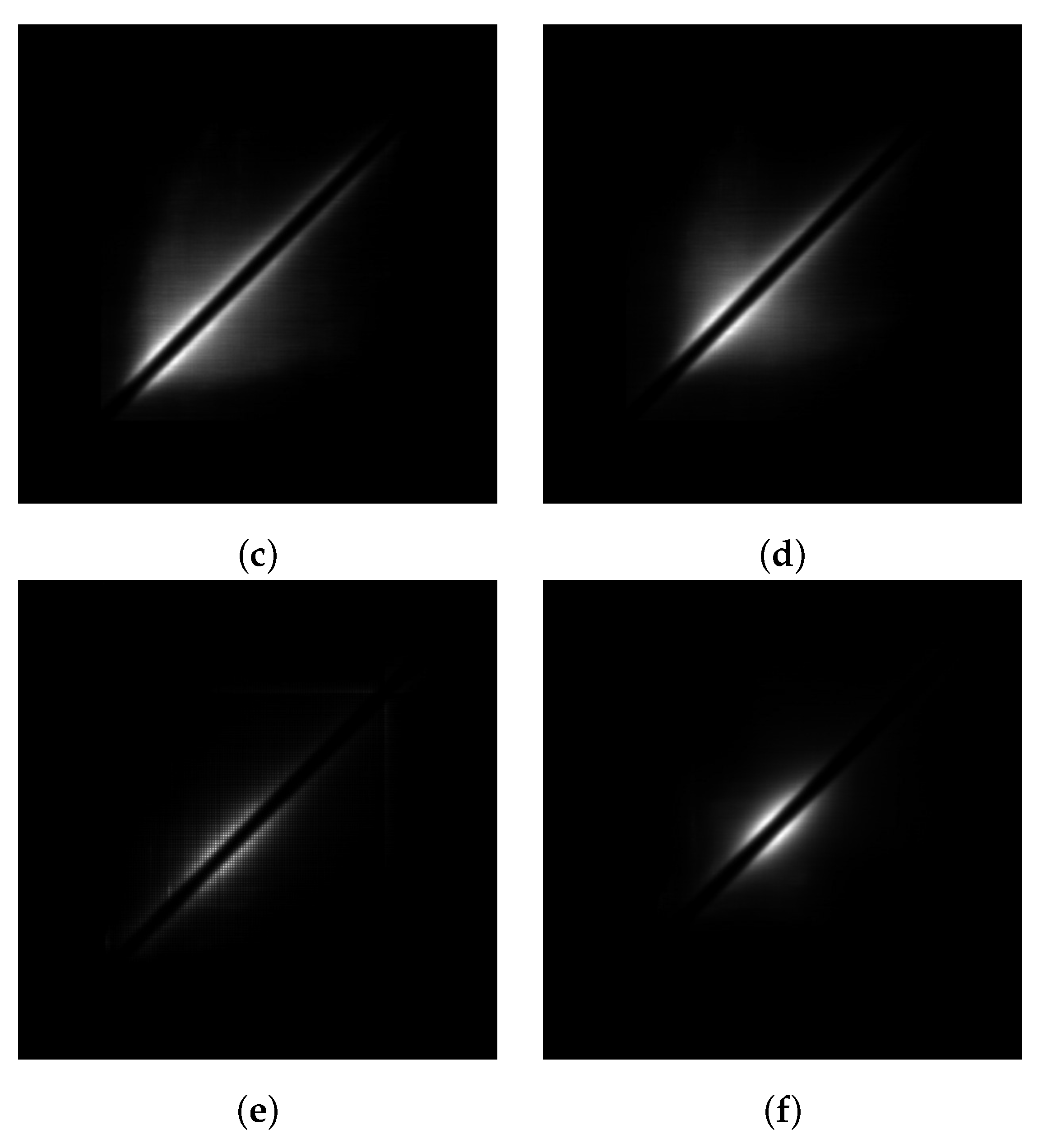


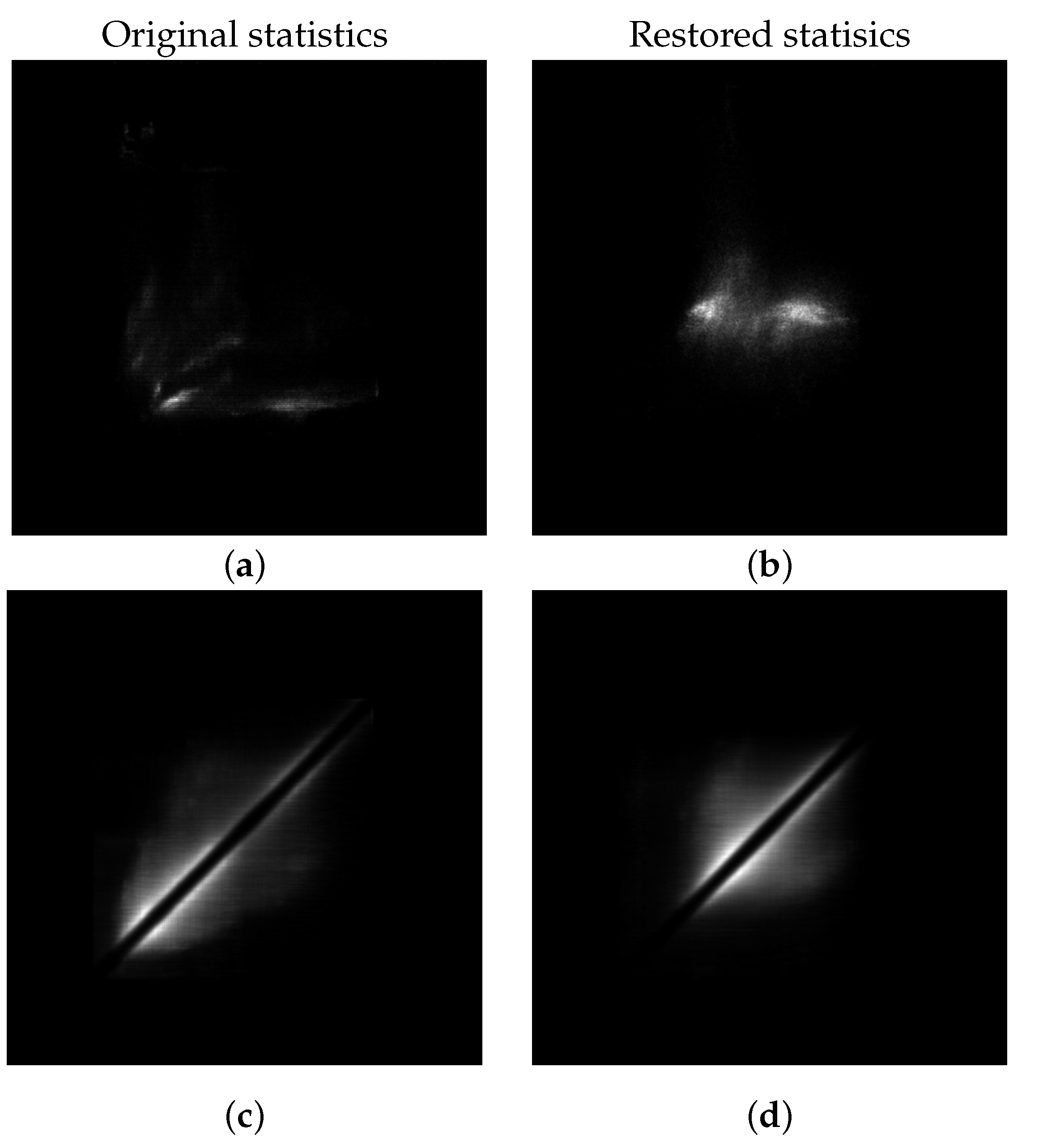
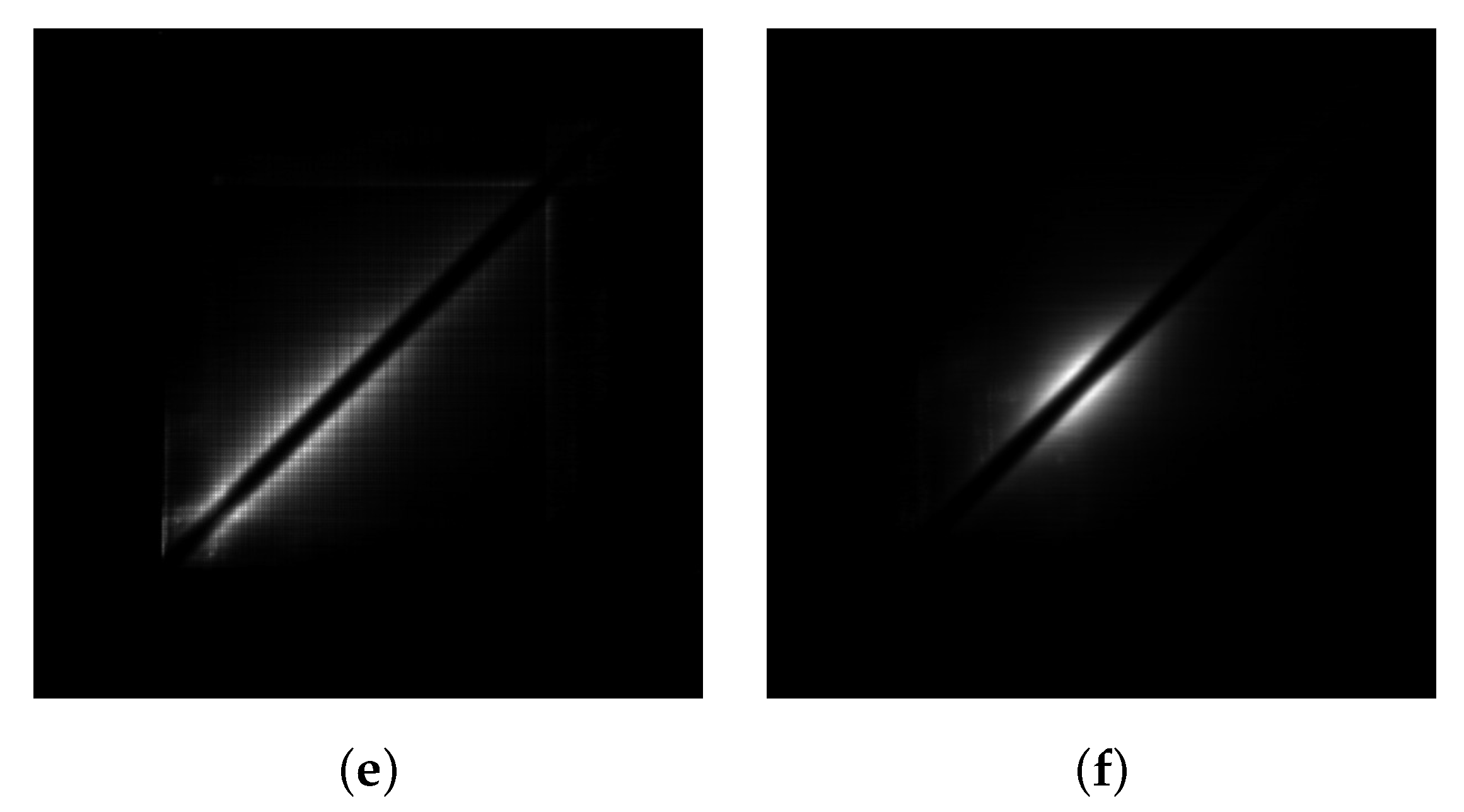
5. Discussion and Conclusions
Author Contributions
Funding
Institutional Review Board Statement
Data Availability Statement
Conflicts of Interest
Abbreviations
| PSF | Point Spread Function |
| RF | Radio-Frequency |
| IRB | Institutional Review Board |
| w | -weighted |
| w | -weighted |
| WB-MRI | Whole-Body Magnetic Resonance Imaging |
| RHS | Right Hand Side |
| ICH GCP | International Conference on Harmonization—Good Clinical Practice |
| TSE | Turbo Spin Echo |
| FFE | Fast Field Echo |
| STIR | Short Tau Inversion Recovery |
| y.o. | Years old |
| MDL | Minimum Description Length |
| MAP | Maximum A Posteriori |
References
- Lecouvet, F.; Simon, M.; Tombal, B.; Jamart, J.; Vande Berg, B.C.; Simoni, P. Whole-body MRI (WB-MRI) versus axial skeleton MRI (AS-MRI) to detect and measure bone metastases in prostate cancer (PCa). Eur. Radiol. 2010, 20, 2973–2982. [Google Scholar] [CrossRef] [PubMed]
- Albano, D.; Cuocolo, R.; Patti, C.; Ugga, L.; Chianca, V.; Tarantino, V.; Faraone, R.; Albano, S.; Micci, G.; Costa, A.; et al. Whole-body MRI radiomics model to predict relapsed/refractory Hodgkin Lymphoma: A preliminary study. Magn. Reson. Imaging 2022, 86, 55–60. [Google Scholar] [CrossRef] [PubMed]
- Grueneisen, J.; Schaarschmidt, B.M.; Heubner, M.; Suntharalingam, S.; Milk, I.; Kinner, S.; Heubner, A.; Forsting, M.; Lauenstein, T.; Ruhlmann, V.; et al. Implementation of FAST-PET/MRI for whole-body staging of female patients with recurrent pelvic malignancies: A comparison to PET/CT. Eur. J. Radiol. 2015, 84, 2097–2102. [Google Scholar] [CrossRef]
- Petralia, G.; Zugni, F.; Summers, P.; Bellomi, M.; Petralia, G. Whole-body magnetic resonance imaging (WB-MRI) for cancer screening: Recommendations for use. Diagn. Imaging Oncol. 2021, 126, 1434–1450. [Google Scholar] [CrossRef]
- Thomas, E.; Fitzpatrick, J.; Malik, S.; Taylor-Robinson, S.; Bell, J. Whole body fat: Content and distribution. Prog. Nucl. Magn. Reson. Spectrosc. 2013, 73, 56–80. [Google Scholar] [CrossRef]
- Thomas, E.; Saeed, N.; Hajnal, J.; Brynes, A.; Goldstone, A.P.; Frost, G.; Bell, J.D. Magnetic resonance imaging of total body fat. J. Appl. Physiol. 1998, 85, 1778–1785. [Google Scholar] [CrossRef]
- Medina, T.; Kolb, J.; Hüttmann, G.; Huber, R.; Medina, O.; Ha, L.; Ulloa, P.; Larsen, N.; Ferrari, A.; Rafecas, M.; et al. Imaging Inflammation—From Whole Body Imaging to Cellular Resolution. Front. Immunol. 2021, 12, 692222. [Google Scholar] [CrossRef]
- Noterdaeme, O.; Brady, M. A Fast Method for Computing and Correcting Intensity Inhomogeneities in MRI. In Proceedings of the International Symposium on Biomedical Imaging (ISBI), Paris, France, 14–17 May 2008; pp. 1525–1528. [Google Scholar]
- Lui, D.; Modhafar, A.; Haider, M.; Wong, A. Monte Carlo-based Noise Compensation in Coil Intensity Corrected Endorectal MRI. BMC Med. Imaging 2015, 15. [Google Scholar] [CrossRef]
- Hooijmans, M.; Dzyubachyk, O.; Nehrke, K.; Koken, P.; Versluis, M.J.; Kan, H.E.; Börnert, P. Fast multistation water/fat imaging at 3T using DREAM-based RF shimming. J. Magn. Reson. Imaging 2015, 42, 217–223. [Google Scholar] [CrossRef]
- Zheng, Y.; Gee, J. Estimation of Image Bias Field with Sparsity Constraints. In Proceedings of the IEEE Computer Society Conference on Computer Vision and Pattern Recognition, San Francisco, CA, USA, 13–18 June 2010; pp. 255–262. [Google Scholar]
- Ma, W.; Morel, J.M.; Osher, S.; Chien, A. An L1-based variational model for Retinex theory and its application to medical images. In Proceedings of the Conference on Computer Vision and Pattern Recognition (CVPR), Colorado Springs, CO, USA, 20–25 June 2011; pp. 153–160. [Google Scholar] [CrossRef]
- Li, C.; Gore, J.; Davatzikos, C. Multiplicative intrinsic component optimization (MICO) for MRI bias field estimation and tissue segmentation. Magn. Reson. Imaging 2014, 32, 913–923. [Google Scholar] [CrossRef]
- Li, C.; Huang, R.; Ding, Z.; Gatenby, J.; Metaxas, D.; Gore, J. A Level Set Method for Image Segmentation in the Presence of Intensity Inhomogeneities With Application to MRI. IEEE Trans. Image Process. 2011, 20, 2007–2016. [Google Scholar] [PubMed]
- Zhang, H.; Ye, X.; Chen, Y. An Efficient Algorithm for Multiphase Image Segmentation with Intensity Bias Correction. IEEE Trans. Image Process. 2013, 22, 3842–3851. [Google Scholar] [CrossRef] [PubMed]
- Mangin, J. Entropy minimization for automatic correction of intensity nonuniformity. In Proceedings of the IEEE Workshop on MMBIA, Hilton Head, SC, USA, 12 June 2000; pp. 162–169. [Google Scholar]
- Simoncelli, E.; Adelson, E. Noise Removal via Bayesian Wavelet Coring. In Proceedings of the 3rd IEEE International Conference on Image Processing (ICIP), Lausanne, Switzerland, 16–19 September 1996; Volume 1, pp. 379–382. [Google Scholar]
- Vidal-Pantaleoni, A.; Martí, D. Comparison of different speckle reduction techniques in SAR images using wavelet transform. Int. J. Remote Sens. 2004, 25, 4915–4932. [Google Scholar] [CrossRef]
- Sled, J.; Zijdenbos, A.; Evans, A. A nonparametric method for automatic correction of intensity nonuniformity in MRI data. IEEE Trans. Med. Imaging 1998, 17, 87–97. [Google Scholar] [CrossRef]
- Renugadevi, M.; Varghese, D.; Vaithiyanathan, V.; Raju, N. Variational Level Set Segmentation and Bias Correction of Fused Medical Images. Asian J. Med. Sci. 2012, 4, 66–74. [Google Scholar]
- Fan, A.; Wells III, W.; Fisher III, J.; Cetin, M.; Haker, S.; Mulkern, R.; Tempany, C.; Willsky, A. A Unified Variational Approach to Denoising and Bias Correction in MR. In Information Processing in Medical Imaging, Proceedings of the 18th International Conference, IPMI 2003, Ambleside, UK, 20–25 July 2003; Springer: Berlin/Heidelberg, Germany, 2003; Volume 2732, pp. 148–159. [Google Scholar]
- Vovk, U.; Pernus, F.; Likar, B. Intensity inhomogeneity correction of multispectral MR images. Neuroimage 2006, 32, 54–61. [Google Scholar] [CrossRef]
- Miller, E.; Jain, V. Many heads are better than one: Jointly removing bias from multiple MRIs using nonparametric maximum likelihood. In Proceedings of the 19th International Conference on Information Processing in Medical Imaging, IPMI 2005, Glenwood Springs, CO, USA, 10–15 July 2005; Volume 3565, pp. 615–626. [Google Scholar]
- Iglesias, J.E.; Dinov, I.; Singh, J.; Tong, G.; Tu, Z. Synthetic MRI Signal Standardization: Application to Multi-atlas Analysis. In Proceedings of the Medical Image Computing and Computer-Assisted Intervention—MICCAI 2010, Beijing, China, 20–24 September 2010; Jiang, T., Navab, N., Pluim, J.P.W., Viergever, M.A., Eds.; Springer: Berlin/Heidelberg, Germany, 2010; Volume 6363, pp. 81–88. [Google Scholar]
- Jog, A.; Roy, S.; Carass, A.; Prince, J. Pulse sequence based multi-acquisition MR intensity normalization. In Proceedings of the Medical Imaging 2013: Image Processing, Lake Buena Vista, FL, USA, 9–14 February 2013; Ourselin, S., Haynor, D.R., Eds.; International Society for Optics and Photonics, SPIE: Bellingham, WA, USA, 2013; Volume 8669, p. 86692H. [Google Scholar] [CrossRef]
- Nyul, L.; Udupa, J. On standardizing the MR image intensity scale. Magn. Reson. Med. 1999, 42, 1072–1081. [Google Scholar] [CrossRef]
- Schmidt, M. A Method for Standardizing MR Intensities between Slices and Volumes; Technical Report, TR05-14; University of Alberta: Edmonton, AB, Canada, 2005. [Google Scholar] [CrossRef]
- Weisenfeld, N.; Warfield, S. Normalization of joint image-intensity statistics in MRI using the Kullback-Leibler divergence. In Proceedings of the 2004 2nd IEEE International Symposium on Biomedical Imaging: Nano to Macro (IEEE Cat No. 04EX821), Arlington, VA, USA, 15–18 April 2004; Volume 1, pp. 101–104. [Google Scholar] [CrossRef]
- Bergeest, J.P.; Jäger, F. A Comparison of Five Methods for Signal Intensity Standardization in MRI. In Proceedings of the Bildverarbeitung für die Medizin 2008, Berlin, Germany, 6–8 April 2008; Tolxdorff, T., Braun, J., Deserno, T.M., Horsch, A., Handels, H., Meinzer, H.P., Eds.; Springer: Berlin/Heidelberg, Germany, 2008; pp. 36–40. [Google Scholar]
- Madabhushi, A.; Udupa, J. Interplay between intensity standardization and inhomogeneity correction in MR image processing. IEEE Trans. Med. Imaging 2005, 24, 561–576. [Google Scholar] [CrossRef]
- Robinson, K.; Ghita, O.; Whelan, P.F. Intensity non-uniformity correction in multi-section whole body MRI. In Proceedings of the Opto-Ireland 2005: Imaging and Vision, Dublin, Ireland, 5–6 April 2005; Murtagh, F.D., Ed.; International Society for Optics and Photonics, SPIE: Bellingham, WA, USA, 2005; Volume 5823, pp. 164–174. [Google Scholar] [CrossRef]
- Jäger, F.; Nyúl, L.; Frericks, B.; Wacker, F.; Hornegger, J. Whole Body MRI Intensity Standardization. In Proceedings of the Bildverarbeitung für die Medizin 2007, Munich, Germany, 25–27 March 2007; Horsch, A., Deserno, T.M., Handels, H., Meinzer, H.P., Tolxdorff, T., Eds.; Springer: Berlin/Heidelberg, Germany, 2007; pp. 459–463. [Google Scholar]
- Jager, F.; Hornegger, J. Nonrigid Registration of Joint Histograms for Intensity Standardization in Magnetic Resonance Imaging. IEEE Trans. Med. Imaging 2009, 28, 137–150. [Google Scholar] [CrossRef]
- Li, C.; Xu, C.; Anderson, A.; Gore, J. MRI Tissue Classification and Bias Field Estimation Based on Coherent Local Intensity Clustering: A Unified Energy Minimization Framework. In Proceedings of the International Conference on Information Processing in Medical Imaging IPMI 2009, Williamsburg, VA, USA, 5–10 July 2009; Volume 5636, pp. 288–299. [Google Scholar]
- Dzyubachyk, O.; van der Geest, R.J.; Staring, M.; Börnert, P.; Reijnierse, M.; Bloem, J.L.; Lelieveldt, B.P.F. Joint Intensity Inhomogeneity Correction for Whole-Body MR Data. In Proceedings of the Medical Image Computing and Computer-Assisted Intervention—MICCAI 2013, Nagoya, Japan, 22–26 September 2013; Mori, K., Sakuma, I., Sato, Y., Barillot, C., Navab, N., Eds.; Springer: Berlin/Heidelberg, Germany, 2013; Volume 8149, pp. 106–113. [Google Scholar]
- Tustison, N.; Avants, B.; Cook, P.; Zheng, Y.; Egan, A.; Yushkevich, P.; Gee, J. N4ITK: Improved N3 Bias Correction. IEEE Trans. Med. Imaging 2010, 29, 1310–1320. [Google Scholar] [CrossRef]
- Dzyubachyk, O.; Staring, M.; Reijnierse, M.; Lelieveldt, B.; Geest, R. Inter-station intensity standardization for whole-body MR data. Magn. Reson. Med. 2016, 77, 422–433. [Google Scholar] [CrossRef]
- Perona, P.; Malik, J. Scale-space and edge detection using anisotropic diffusion. IEEE Trans. Pattern Anal. Mach. Intell. 1990, 12, 629–639. [Google Scholar] [CrossRef]
- Sapiro, G. Geometric Partial Differential Equations and Image Analysis; Cambridge University Press: Cambridge, UK, 2001. [Google Scholar]
- Sapiro, G. Geometric partial differential equations in image analysis: Past, present, and future. In Proceedings of the International Conference on Image Processing, 1995, Washington, DC, USA, 23–26 October 1995; Volume 3, pp. 1–4. [Google Scholar] [CrossRef]
- Leclerc, Y. Constructing simple stable descriptions for image partitioning. Int. J. Comput. Vis. 1989, 3, 73–102. [Google Scholar] [CrossRef]
- Leclerc, Y. The Local Structure of Image Intensity Discontinuities; McGill University: Montreal, QC, Canada, 1989. [Google Scholar]
- Yue, H.; Yang, J.; Sun, X.; Wu, F.; Hou, C. Contrast Enhancement Based on Intrinsic Image Decomposition. IEEE Trans. Image Process. 2017, 26, 3981–3994. [Google Scholar] [CrossRef]
- Bi, S.; Han, X.; Yu, Y. An L1 image transform for edge-preserving smoothing and scene-level intrinsic decomposition. ACM Trans. Graph. 2015, 34, 1–12. [Google Scholar] [CrossRef]
- Cai, J.F.; Dong, B.; Shen, Z. Image restoration: A wavelet frame based model for piecewise smooth functions and beyond. Sparse Representations with Applications in Imaging Science, Data Analysis and Beyond. Appl. Comput. Harmon. Anal. 2016, 41, 94–138. [Google Scholar] [CrossRef]
- Trzasko, J.; Manduca, A. Highly Undersampled Magnetic Resonance Image Reconstruction via Homotopic ℓ0 -Minimization. IEEE Trans. Med. Imaging 2009, 28, 106–121. [Google Scholar] [CrossRef]
- Krissian, K.; Aja-Fernandez, S. Noise-Driven Anisotropic Diffusion Filtering of MRI. IEEE Trans. Image Process. 2009, 18, 2265–2274. [Google Scholar] [CrossRef]
- Leclerc, Y.G.; Zucker, S.W. The Local Structure of Image Discontinuities in One Dimension. IEEE Trans. Pattern Anal. Mach. Intell. 1987, PAMI-9, 341–355. [Google Scholar] [CrossRef]
- Hadjidemetriou, S.; Studholme, C.; Mueller, S.; Weiner, M.; Schuff, N. Restoration of MRI data for intensity non-uniformities using local high order intensity statistics. Med. Image Anal. 2009, 13, 36–48. [Google Scholar] [CrossRef]
- Hadjidemetriou, S.; Buechert, M.; Ludwig, U.; Hennig, J. Joint Restoration of Bi-contrast MRI Data for Spatial Intensity Non-uniformities. In Information Processing in Medical Imaging, Proceedings of the 22nd International Conference, IPMI 2011, Kloster Irsee, Germany, 3–8 July 2011; Springer: Berlin/Heidelberg, Germany, 2011; Volume 6801, pp. 346–358. [Google Scholar]
- Hadjidemetriou, S.; Psychogios, M.N.; Lingor, P.; Von Eckardstein, K.; Papageorgiou, I. Restoration of Bi-Contrast MRI Data for Intensity Uniformity with Bayesian Coring of Co-Occurrence Statistics. J. Imaging 2017, 3, 67. [Google Scholar] [CrossRef]
- Hadjidemetriou, S.; Psychogios, M.N.; Lingor, P.; von Eckardstein, K.; Papageorgiou, I. Restoration of Intensity Uniformity of Bi-contrast MRI Data with Bayesian Co-Occurrence Coring. In Proceedings of the Medical Image Understanding and Analysis—21st Annual Conference, MIUA 2017, Edinburgh, UK, 11–13 July 2017; del C. Valdés Hernández, M., González-Castro, V., Eds.; Springer: Berlin/Heidelberg, Germany, 2017; Volume 723, pp. 616–628. [Google Scholar] [CrossRef]
- Papageorgiou, I.; Dvorak, J.; Cosma, I.; Pfeil, A.; Teichgraeber, U.; Malich, A. Whole-body MRI: A powerful alternative to bone scan for bone marrow staging without radiation and gadolinium enhancer. Clin. Transl. Oncol. 2019, 22, 1321–1328. [Google Scholar] [CrossRef] [PubMed]
- Bennia, A.; Riad, S. Filtering Capabilities and Convergence of the Van-Cittert Deconvolution Technique. IEEE Trans. Instrum. Meas. 1992, 41, 246–250. [Google Scholar] [CrossRef]
- Otsu, N. A Threshold Selection Method from Gray-Level Histograms. IEEE Trans. Syst. Man. Cybern. 1979, 9, 62–66. [Google Scholar] [CrossRef]
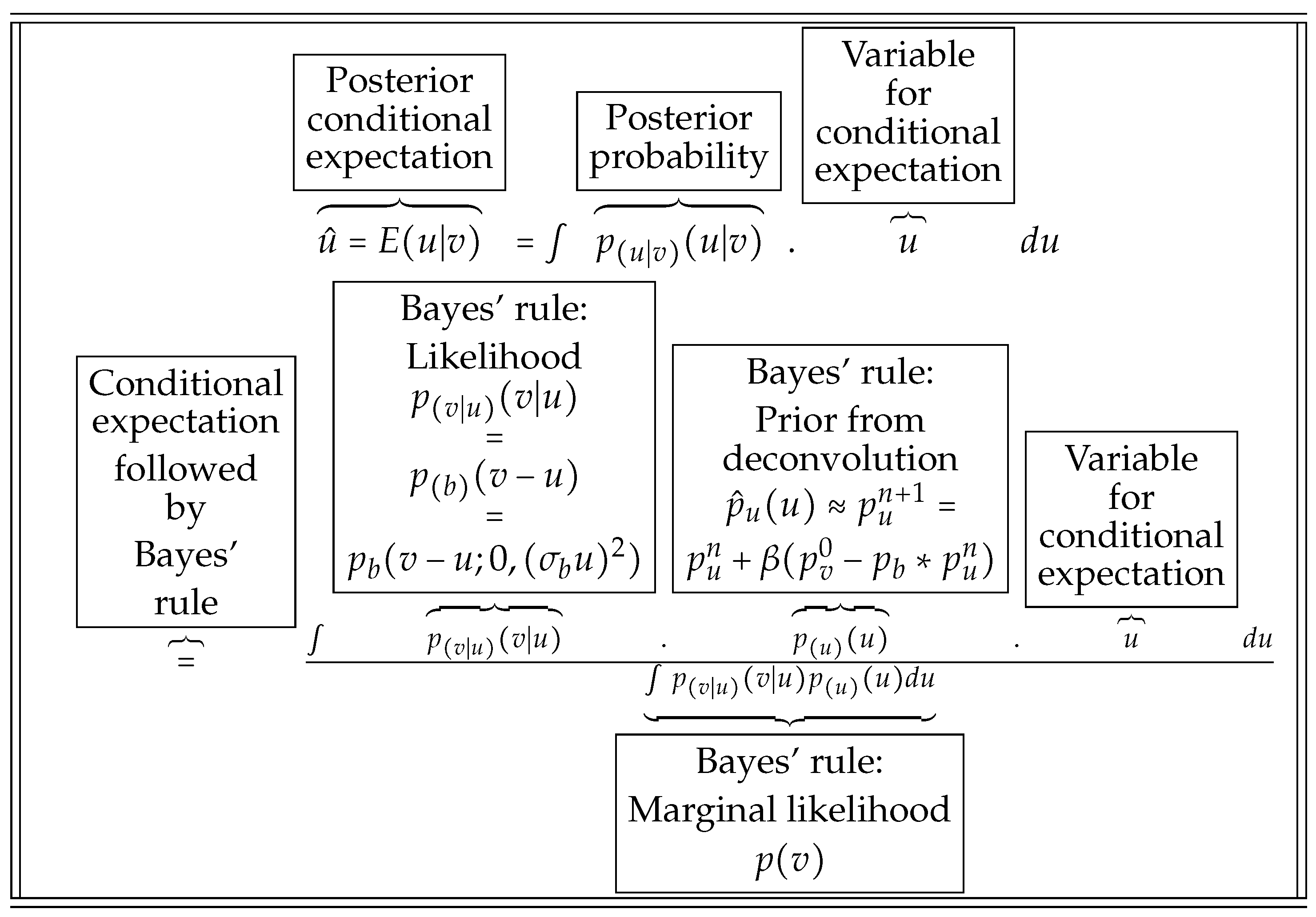
| Parameters ∖ | Sequence, Static Field | w TSE 1.5 T | STIR 1.5 T | w TSE 3.0 T | STIR 3.0 T |
|---|---|---|---|---|---|
| Number of slices | 66 | 66 | 60 | 60 | |
| Voxel size mm2 | |||||
| Slice hickness (mm) | 3 | 3 | 3 | 3 | |
| Spacing (slice gap) (mm) | 0.3 | 0.3 | 1 | 1 | |
| Matrix size | |||||
| Mean | St.Dev. | Median | Minimum | Maximum |
|---|---|---|---|---|
| −0.46 | 0.23 | −0.52 | −0.89 | −0.02 |
Disclaimer/Publisher’s Note: The statements, opinions and data contained in all publications are solely those of the individual author(s) and contributor(s) and not of MDPI and/or the editor(s). MDPI and/or the editor(s) disclaim responsibility for any injury to people or property resulting from any ideas, methods, instructions or products referred to in the content. |
© 2023 by the authors. Licensee MDPI, Basel, Switzerland. This article is an open access article distributed under the terms and conditions of the Creative Commons Attribution (CC BY) license (https://creativecommons.org/licenses/by/4.0/).
Share and Cite
Hadjidemetriou, S.; Malich, A.; Rossknecht, L.D.; Ferrarini, L.; Papageorgiou, I.E. Restoration for Intensity Nonuniformities with Discontinuities in Whole-Body MRI. Signals 2023, 4, 725-745. https://doi.org/10.3390/signals4040040
Hadjidemetriou S, Malich A, Rossknecht LD, Ferrarini L, Papageorgiou IE. Restoration for Intensity Nonuniformities with Discontinuities in Whole-Body MRI. Signals. 2023; 4(4):725-745. https://doi.org/10.3390/signals4040040
Chicago/Turabian StyleHadjidemetriou, Stathis, Ansgar Malich, Lorenz Damian Rossknecht, Luca Ferrarini, and Ismini E. Papageorgiou. 2023. "Restoration for Intensity Nonuniformities with Discontinuities in Whole-Body MRI" Signals 4, no. 4: 725-745. https://doi.org/10.3390/signals4040040
APA StyleHadjidemetriou, S., Malich, A., Rossknecht, L. D., Ferrarini, L., & Papageorgiou, I. E. (2023). Restoration for Intensity Nonuniformities with Discontinuities in Whole-Body MRI. Signals, 4(4), 725-745. https://doi.org/10.3390/signals4040040







